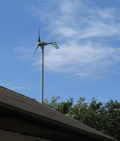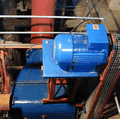Smaller kit cuts costs

Even if you don’t want to tackle big renewable energy projects like wind farms and biogas plants, there are still ways to use smaller equipment to cut costs and maybe reap an unexpected profit. Kevin Lindegaard looks at what’s available:
SOLAR WATERHEATING
What is it?
Solar collectors absorb energy from the sun and convert it into useful heat in the form of hot water. They are usually roof mounted and can be integrated with your normal heating system, including most combi boilers. Systems have been around since the 1970s and there are about 80,000 in the UK.
Can I produce all my heating with this technology?
No. A typical system will provide all your hot water in the summer and about 50-70% of the year-round demand. These systems are best suited to applications with high levels of hot water demand in summer – B&Bs and campsites with shower blocks are good examples.
How much space is required?
A typical farmhouse would need 3-4sq m of south-facing roof space to mount the solar collectors. You will also need space for a hot water cylinder.
How much maintenance is required?
Virtually none. You should check annually to see if any debris (such as leaves and bird droppings) has fallen on the collectors. The panels can be cleaned with soapy water and a soft bristled brush. You may need to replace the anti-freeze after about five years.
What does it cost?
£2500-4000 depending on the type and size of collector. Flat-plate collectors are the cheapest evacuated tubes are the most expensive, but are more efficient. Beware of junk mail and door-to-door solar salesmen that promise savings that are too good to be true. Always get several quotes before committing to an installer.
There are several solar clubs established around the country that can offer advice on DIY installations. This would reduce the outlay to £1000-1500, but will require time to learn the skills needed. Also a DIY installation is not eligible for a grant and you will have to pay VAT at 17.5% rather than 5% for installations by accredited installers.
Can I get a grant?
The Low Carbon Buildings programme offers £400 towards the cost.
Payback period?
15-25 years if electric water heating is replaced. A DIY system could pay back in less than 10 years.
Are there any planning issues?
Yes, especially on listed buildings or those in a conservation area.
Advice and suppliers?
See the Solar Trade Association.
GROUND SOURCE HEAT PUMP
What is it?
A length of plastic pipe is buried in a trench or vertical borehole and a mixture of water and antifreeze absorbs heat from the ground. A pump uses electricity to drive a compressor to raise this heat to a useful temperature, it’s then distributed around the dwelling by underfloor heating or radiators. The system requires electricity to drive the pump, so could be integrated with a small wind turbine to make it completely renewable. There are only 550 systems in the UK, but as many as 500,000 in North America and Scandinavia.
Can I produce all my heating with this technology?
Yes, but it would be more cost-effective to size your system according to your base heating load and have a fossil-fuel-driven immersion system to kick in during times of peak need. Best for new build where a trench can be excavated during the building works and underfloor heating incorporated in the design. A high level of insulation is necessary to make the most of this technology.
How much space is required?
The ground loop needs a trench 75-100m long and 1-2m in depth for a typical farmhouse. Vertical holes are also possible, but are more expensive. The pump itself is a square box similar in size to a fridge.
How much maintenance is required?
Virtually none.
What does it cost?
A typical 8kW system costs between £6400 and £9600, but that doesn’t include the cost of your distribution system. An underfloor heating system is best, although it is also possible to use radiators. An average farmhouse would be looking at a total outlay of £10,000-13,000.
Can I get a grant?
The Low Carbon Buildings programme offers a maximum of £1200 regardless of size and subject to an overall limit of 30%.
Payback period?
If you replace an electric night storage system you would expect to save up to two-thirds on your bills, enabling the system to pay for itself in 16-21 years.
Are there any planning issues?
Not as a rule.
Advice and suppliers?
See the Ground Source Heat Pump Club
ROOF-MOUNTED WIND TURBINE
What is it?
Wind turbines suitable for mounting to buildings typically range from small 100W machines used to charge 12-24 volt batteries to 2.5kW ones that can export electricity to the grid during times when more electricity is produced than can be used. Roof-mounted turbines are particularly useful where mains electricity is not available or is expensive to connect.
Can I produce all my electricity with this technology?
Unlikely. A small 1kW turbine with a 1.75m blade might produce about 650kWh a year at an average wind speed of 4.5m/sec. This is about 20% of typical household requirements.
When mounting the turbine you should avoid sites with excessive turbulence, which will reduce performance and shorten the working life of the turbine. Best results would be about 10m above surrounding buildings and trees – in most cases this is unlikely to be possible, so you will have to accept a reduction in performance. Vibration can cause problems if the turbine is fixed to a brick building.
You can get an average windspeed estimate for your postcode from the British Wind Energy Website.
How much maintenance is required?
The service schedule will be specified by the manufacturer. At the very least an annual inspection should be performed to check for damage to the blades and other components.
What does it cost?
A 1 kW Windsave turbine can be bought from B&Q for £1498 fully installed, but prices for other small turbines can rise to £3000/kW. This includes the turbine, mast, inverters and batteries (if required).
The most economical option is to consume the electricity that you produce. Selling surplus to the grid will mean installing a £400 export meter.
Can I get a grant?
The Low Carbon Buildings programme offers a maximum of £1000/kW installed, up to a maximum of £5000 and subject to a maximum of 30% of the project costs. So you might get £478 towards a 1kW unit.
Payback period?
A 1kW Windsave producing 650kWh would save about £75 a year based on current electricity prices. With a grant, it would pay for itself in 15 years.
Are there any planning issues?
The government has proposed classing micro-renewables on existing houses as permitted development. In the meantime it would be advisable to contact your local authority planning department before you start work.
Advice and suppliers?
British Wind Energy Association or Windsave
STAND-ALONE WIND TURBINE
What is it?
Stand-alone wind turbines are mounted on masts up to 15m high and range in capacity from 600W to more than 20kW.
Can I produce all my electricity with this technology?
Yes. Stand-alone turbines have fewer restrictions on where they can be located, so you should aim to find a windy site with limited obstruction from trees and other buildings. Wind speed increases at greater heights, so a well-sited 15m 6kW Proven 6000 turbine with a blade diameter of 5.5m should be capable of producing 7500kWh of electricity at an average wind speed of 5 m/sec.
This is double the needs of a normal home, so you should be able to power other farm activities as well or provide a neighbour via a private wire.
This is a good option if you have other power-hungry activities on your farm such as a milking parlour or farm offices. As with all renewable electricity technologies it is best to use what you produce rather than selling it to a supplier.
How much maintenance is required?
The same as for roof-mounted wind turbines.
What does it cost?
A 6kW Proven 6000 with a 15m tower costs £19,000 including grid connection. The land owner is required to carry out foundation work and laying concrete. This might cost an additional £3000. A system to charge batteries costs £24,000.
Can I get a grant? 
The Low Carbon Buildings Programme offers a maximum of £1000/kW installed up to a maximum of £5000 and subject to a maximum of 30% of the project costs. So you could get £5000 towards the cost of a Proven 6000.
Payback period?
A turbine producing 7500kWh of electricity could save you £900 a year. With a grant a Proven 6000 would pay for itself in 15-20 years. Sites with greater average wind speeds will pay back even quicker.
Are there any planning issues?
As for roof-mounted wind turbines. Small turbines with mast heights lower than 15m don’t need an Environmental Impact Assessment (EIA) and are permitted in National Parks and Areas of Outstanding Natural Beauty as long as there is no serious environmental detriment to the area concerned.
| ADVICE AND SUPPLIERS? |
PHOTOVOLTAICS
What is it?
Photovoltaics or PV systems involve two or more thin layers of semiconducting material which, when exposed to light, generate an electrical charge. Panels are roof-mounted either on top of existing tiles or (if you are changing your roof) as integrated tiles. There are 1500 PV roofs in the UK, but 100,000 in Germany.
Can I produce all my electricity with this technology?
You could, but you are likely to run out of roof space. A 1kW system might produce 800-1000 kWh of electricity a year depending on your location (the intensity of solar energy is much greater in Dorset than in Dumfries). This would be sufficient to provide about 25% of your yearly requirements.
They are useful in remote areas off the electricity grid, but might need lifestyle changes to get the best from the system – for instance using power hungry appliances like washing machines only during the day.
How much space is required?
A 1 kW system would require an area of 10sq m of south-facing roof space.
How much maintenance is required?
Virtually none.
What does it cost?
A 1kW system will cost £5000-£10,000. There are various types of PV cells, but the most efficient (and expensive) ones are monocrystalline, which convert about 15% of the available solar irradiation into electricity. Thin-film amorphous silicon cells are cheaper, but only achieve about 7% efficiency.
The most cost-effective option is to use all the electricity that you produce, thereby saving 12p for every kWh you produce yourself. If you wish to export surplus to the grid you will need an export meter costing £400 and the best price you will get is about 8p/kWh.
Can I get a grant?
The Low Carbon Buildings programme offers a maximum of £3000/kW installed up to a maximum of £15,000 and subject to an overall limit of 50% of installation costs. A 1kW unit costing £8000 might get a grant of £4000.
Payback period?
An £8000 PV system producing 800kWh a year would save about £96 a year compared with buying electricity from the grid. The system would be expected to last for 25-30 years, but electricity prices would need to increase by a further 50-60% to see a payback during its lifetime. The government is looking at ways to make solar PV more cost competitive by price banding (a guaranteed electricity price set above other more mature renewable technologies).
PV cells are energy intensive to make and can take up to five years of solid use to repay their carbon debt (the amount of CO2 emitted during manufacture). If the system is used in conjunction with batteries the carbon debt might be 10 years.
Are there any planning issues?
Yes, especially on listed buildings or those in a conservation area.
Advice and suppliers?
MICRO HYDRO
What is it?
Fast-flowing water contains a great deal of energy and this can be converted to electricity by a turbine. The energy contained in a particular stretch of water depends on the vertical height that the water falls (known as the head) and its flow rate.
Low-head and high-head schemes are possible, but require different turbine types. As a general rule, schemes with larger heads require smaller turbines.
Components of the scheme will include an intake which diverts the water from the river, a pipe known as a penstock which transfers the water to the powerhouse accommodating the turbine and generator and an outflow which returns the water to the river. There are various layout options depending on your site and its head and flow rate (see the British hydro Power association website). 
This technology is particularly valid for sites with old water mills, as this will significantly reduce infrastructure costs. There are between 30,000 and 40,000 disused water mills sites in the UK, but only about 50 are used for power production.
Alternatively, hilly areas with spring-fed streams or rivers with as little as a 1m head may also be suitable. You can get a rough estimate of the flow rate of your site by consulting the National River Flow Archive held by the Centre for Ecology and Hydrology (see more information).
Can I produce all my electricity with this technology?
Yes. In fact you are likely to produce much more than you need. You can either export directly to the grid which will require a convenient connection into the local distribution network or sell the power locally via a private wire.
The flow of the water will vary throughout the year, so a 10kW system might be able to achieve its full potential for 40-50% of the year. A conservative capacity factor of 40% would enable the production of 35,040 kWh a year, enough electricity for 10 homes.
What does it cost?
Low-head schemes ranging between 5 and 20m cost £3000-£4000/kW installed. So a 10kW system could cost about £30,000-£40,000. Suitable micro hydro sites offer potential for a high return on your investment.
Can I get a grant?
The Low Carbon Buildings programme offers a maximum of £1000/kW installed up to a maximum of £5000 and subject to an overall limit of 30% of installation costs. A 10 kW system costing £40,000 might get a grant of £5000.
Payback period?
It is possible to get a pooled price of 8p/kWh from electricity suppliers that includes the wholesale price of electricity, renewable obligation and levy exemption certificates.
A 10kW system producing 35,000kWh a year would bring in an annual income of £2800. A £30,000-40,000 project would, therefore, pay back in about 9-13 years. If you use the electricity yourself or sell it locally the payback would be reduced to 7-9 years on current prices.
How much maintenance is required?
Once a scheme is established it requires very little maintenance apart from routine inspections and an annual service. This might cost £400-£800 a year for a 10kW system. After 10 years or so there might be a need to replace seals and bearings and fit a new generator and refurbish sluice gates.
Are there any planning issues?
You should consult your local planning authority and the Environment Agency before you start any development. Planning permission will require various consents and licences including an Environmental Statement and an abstraction licence.
Issues that must be addressed include any effects on wildlife, noise impacts, visual appearance, any disruption caused during construction, preservation of any archaeological remains and air and water quality.
Special requirements are required by rivers populated by migrating species of fish such as salmon or trout and might dictate the incorporation of a “fish ladder” so that fish can move up and down the river and avoid the turbine blades.
Advice?
- For advice and a list of suppliers see the British Hydro Power Association
- National River Flow Archive
SMALL-SCALE BIOMASS HEATING
What is it?
Logs, chips, wheat and sawdust pellets can be used in domestic systems to provide space and water heating. They do produce CO2, but this is absorbed by new trees or crops planted to replace the ones used.
Automatic wood heating systems are far more efficient than traditional open fires or wood-burning stoves. They also provide a manageable heat source that is controlled by thermostats and require far less maintenance. There are fewer than 1000 systems in the UK, but over 100,000 installations in Austria.
Can I produce all my heating with this technology?
Yes, depending on which technology you go for. A room heater is like having a gas fire or wood stove and provides additional heating to a room. Some models can be fitted with a back boiler to provide hot water. Log and pellet boilers are larger installations that can provide all the space and water heating of a house.
Woodchip boilers are cost effective for high heat loads such as a large farmhouse and farm offices. With the latter you can sell heat to office tenants as part of a heat meter. A small biomass boiler might save you thousands of pounds over its lifetime and should be on your shopping list if you live in a rural area off the gas grid, have ample space to accommodate the boiler and fuel storage and don’t mind a hands-on heating system
Moisture content and fuel quality
The moisture content (MC) of your chosen fuel dictates your choice of boiler technology. A wetter fuel such as tree prunings (MC above 35%) will require a more expensive moving grate type boiler while drier fuels such as chipped round wood or pellets (less than 35% MC) can use a fixed hearth.
How much space is required?
Wood has a lower energy content than fossil fuels, so you need more of it to provide the same amount of heating. An old house with a total water and heating demand of 25,000 kWh would require about 3cu m of oil, but about four times this volume of pellets, 10 times the volume of logs and 15 times this volume of woodchip at 25% MC. Hence, if you wish to go for the boiler option you must have sufficient space to accommodate bulk deliveries of wood fuel.
A room heater fuelled by pellets might only be required a few hours a day during the winter months. With an annual heating demand of 1800kWh, it would only require space to store 360kg of pellets.
You will also need space to accommodate the boiler and hopper. This generally is about double the space required by an oil boiler. Room heaters tend to be a similar size to propane room heaters. Both systems require a flue.
How much maintenance is required?
You will have to empty the ash pan from time to time. This might be weekly for large boilers to a few times a year with room heaters. Once (maybe twice) during the heating season the boiler might need to be shut down completely to allow cleaning of the fire tubes and to grease the augers and transmission chains in the fuel handling system.
What does it cost?
A stand-alone room heater costs from £2000-3000. A log, pellet or grain boiler for a typical house costs between £5000-10,000 while a 100kW woodchip boiler for a farmhouse and offices might cost £30,000.
You will need to budget for fuel.There are a number of options such as clean woodchip from tree pruning, short rotation coppice (SRC) or round wood or untreated waste wood such as pallets and joinery waste.
With the latter you might be able to get a “free” source, but you should factor in a cost for handling and chipping. Even if you’re paying for woodchip, it is still very competitive and is cheaper than mains gas. A cost of £25/t equates to 1p/kWh while gas is 2.5p/kWh and oil at 40p litre is just under 4p/kWh.
Can I get a grant?
The Low Carbon Buildings programme offers a maximum £600 grant for room heaters and automated wood pellet feed equipment as long as the latter is less than 20% of the cost (exclusive of VAT). For wood-fuelled boiler systems the maximum grant is £1500 regardless of size and subject to an overall 30% limit (exclusive of VAT). A new grant for biomass boilers, expected soon, should pay 40% of the cost difference against the purchase of a fossil-fuelled boiler.
What is the payback?
Savings are best in off-gas areas and for properties with high heat loads.
For instance a large farmhouse with a heating requirement of 75,000kWh a year might pay back the cost of conversion from oil or LPG to a woodchip, grain or pellet boiler in 2-4 years on current prices.
For smaller three-bedroom properties with an annual demand of 25,000kWh, the best current paybacks are for grain or log boilers.
A room heater would have to be used fairly extensively to achieve a payback
| ADVICE AND SUPPLIERS? |
.
Are there any planning issues?
Boilers under 3MW are regulated by your local authority Environmental Health Officer. You should notify them before the installation. There are few restrictions if you are using clean woodchip. Using clean wood waste in a boiler above 400kW is regulated under the Local Air Pollution Prevention and Control and will need an annual emissions check.
| GENERAL RENEWABLE ADVICE |
